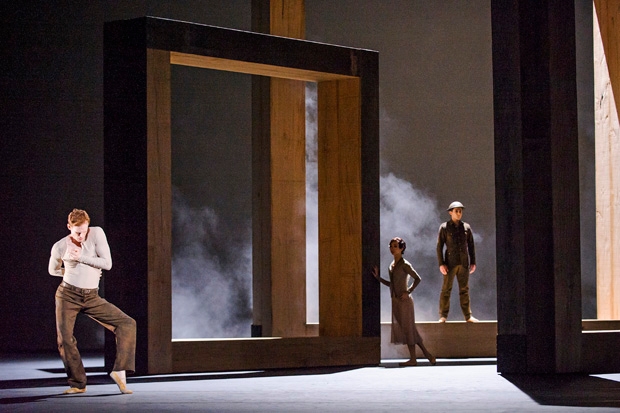People have been saying that Wayne McGregor’s new Woolf Works has reinvented the three-act ballet, but not so. William Forsythe reinvented the three-act ballet 20 years ago with Eidos: Telos, a mesmerising masterpiece that I found myself recalling as I watched the McGregor. There are many formal similarities: the search for sense through words, the woman facing darkness and death, the central act in period costume, spectacular light, video, ambitious structures on stage, and so on. You get the picture. McGregor’s work isn’t reinventing the wheel — it just reinflates it with a jet of new hot air.
Since last week’s première, every possible view has been taken about Royal Ballet’s Woolf Works, from rapture to loathing. I’m entirely in sympathy with both camps, depending on which bit of the show we’re talking about.
First of the pros is the mesmerisingly beautiful Alessandra Ferri, a revenant from the Royal Ballet’s 1980s, now aged 52, who is still unequalled in her dramatic empathy with asthenia and the pain of living. The staggering sights and sounds are also worth your money: part one’s massive wooden frames, a dazzling laser show with some evocative sound-work, the hypnotic film of waves in part three, as Ferri (Virginia Woolf) goes to her death.
Con: the crematorium bilge that is the music. Max Richter is a composer of the type of stuff apparently created by planting a hand on a keyboard in a minor chord, and digitally adding arpeggios, reverb and volume for eight bars at a time, then layering on celestial sopranos until the listeners pass out with tearfulness. It is impossible to think that a woman who talked and wrote like Woolf would tolerate such musical drivel.
On the other hand, it is hopeful to see McGregor tentatively choreographing a new classical handwriting formed to handle Ferri’s evanescent stage charisma and weightless middle-aged body, her genius with slow movement, and her affinity with dying falls. He doesn’t cover much floor with her, but the final, slumbrous duet with Federico Bonelli is ravishingly melancholy. She has evidently mesmerised McGregor, as she mesmerised Kenneth MacMillan 30 years ago.
The middle Orlando-inspired movement returns to his normal jitters mode, with Natalia Osipova looking like a Tudor Dandini in gold-lamé ruff and breeches, arms, eyes, legs dangerously shooting in all directions under the laser rays. She is raring to go, pouncing on the least movement with her own heated meaning, the opposite of Ferri who makes something significant of just the fact of motion at all.
This movement quickly becomes a long haul, however. Woolf mused on the ‘vacillation from one sex to the other’ within each person, and the quasi-masculine possibilities of Osipova and the quasi-feminine aspects of Edward Watson look perfect to illuminate it yet McGregor’s choreography makes the sexes indistinguishable, turns them all into scrappy insectoid bodies. (Particularly unattractive once they strip down their gold fancy clothes to flesh-coloured pants.)
More pros: mischievous Francesca Hayward, snogging Ferri in part one and dancing like a gadfly in part two; and the gloriously laconic white-black pair of Melissa Hamilton and Eric Underwood, who display their preening poses without hurry in a teeming world.
More cons: an unease that what with Ferri’s suffering and Osipova’s crotch shots, McGregor has got the audience excited with a regressive view of woman as victim or doll. And that this work looks less like a new piece of Royal Ballet identity than a sophisticated dual-ballerina vehicle, the ensemble being dancing wallpaper.
Mark Baldwin’s new creation for Rambert Dance has a differently sensational look — the stage is filled with the Tredegar Town Brass Band of south Wales, lit like 32 saints in an icon wall — and it sounds properly sensational too.
Genuine emotions throb through Dark Arteries, Gavin Higgins’s bravura brass music plundering the depths of tubas and the highest skitterings of cornets, with a tart percussive complement. His inspiration is the lost miners of south Wales, his family roots, while Baldwin’s dance appears to draw on other arterial supplies, Rambert’s bloodline.
The women in long plain navy dresses, bending deep, and their circlings and careful formations, summon up echoes of Dark Elegies, Antony Tudor’s 1937 Rambert masterpiece on community loss — and maybe the shade of Martha Graham too, in those hieratic hands and distinctive peremptory arms.
The men, in braces and blue shirts, have a leaping vigour off the ground that is entirely lacking in McGregor, who simply doesn’t do jumps. Two reappear in orange leotards like heralds, and in a very strange, specific movement lock their heads together as in a rugby scrum and slowly go down on all fours, so that they become a slow eight-stumped creature slithering to and fro over the ground. It is the most peculiar and unsettling move of a packed week.






Comments